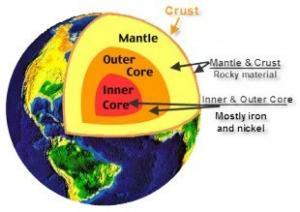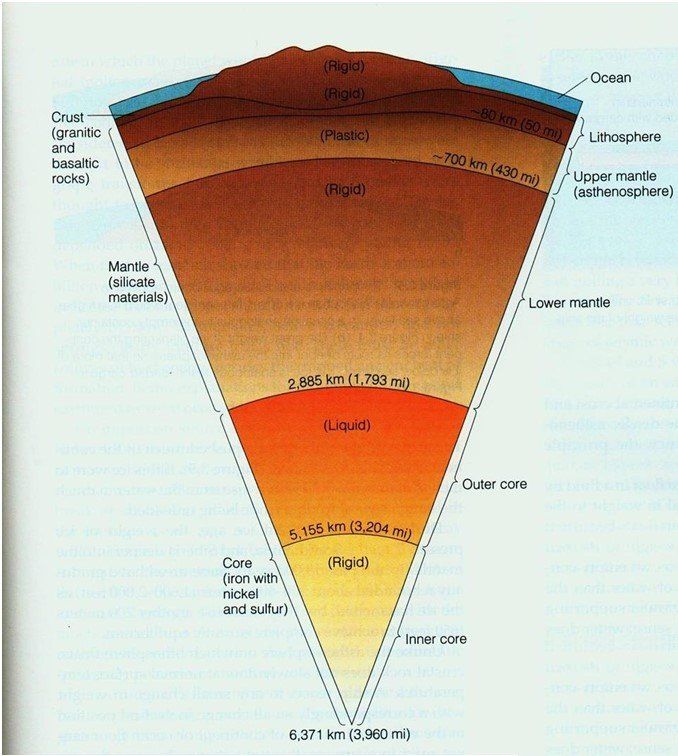7 Layers of the Earth Worksheet
Grade 7 Science Worksheets
The Earth is a dynamic planet composed of several layers, each with its unique characteristics and properties. These layers form the Earth’s structure and are responsible for the diverse geological processes that occur on our planet.
In this article, will learn about the 7 layers of the earth – their names, location and thickness.
Already familiar with the earth’s structure? Test your knowledge with the 7th grade 7 Layers of the Earth Worksheet.
Earth’s Structure
What are the four different layers of the earth?
Geologists have observed vibrations (seismic waves) made by earthquakes to understand the structure of the earth’s inside. They found that it is divided into these distinct layers: the crust, the mantle , outer Core and the inner core.

Credit: https://sites.google.com/site/biologiaygeologiade1eso/home/2-la-tierra
Schedule a Free session to clear worksheet doubts
No credit card required, no obligation to purchase.
Just schedule a FREE Sessions to meet a tutor and get help on any topic you want!
Crust
Crust is the top or the outermost layer. It is very solid, and also the thinnest of all layers, only about 5000m thick under the oceans and about 30000m of thickness under the landmasses.
Mantle
It is made of two parts, upper and lower, the thick upper layer is made of extremely hot, semisolid liquid rock pattern and is located directly below the crust and is about 2,900 km thick.
Outer core
The outer core is the only layer which is a liquid layer: an ocean of mostly thoroughly liquid iron and nickel. It is about 1,800 to 3,000 miles below the surface and about 2,300 km thick.
Inner core
An extremely hot layer, solid ball of iron and nickel at the center of the earth. It is 3,000 to 3,960 miles below the surface and about 1,200 km in diameter.
Lithosphere
Lithosphere is one of the four spheres of earth and is made up of the crust and a very small lining of the upper mantle; it is divided into many slowly moving plates of solid structure that has the continents and oceans above it.
Asthenosphere
The upper mantle makes the plates of the lithosphere move on this hot, liquid magma right below the lithosphere.
Download 7 Layers of the Earth Worksheet to see how well you understood the topic.
How deep are the 7 layers of the earth?

Credit: https://flowvella.com/s/1boy/Travel-brochure?iframe=true
Plate Tectonics
German scientist Alfred Wegener was the first who found that the coastal length of Africa and South America seemed like a jigsaw puzzle that fit together. He also got proof of the same by studying and analyzing the plant and animal fossils along the coasts of these continents, even though now they were separated by vast oceans. He also noticed that physical formations, like mountain ranges, on the two continents also were same.
Later in the book, The Origin of Continents and Oceans, he described that the earth’s continents were once one large mass and called it the supercontinent Pangaea, meaning “all the earth”. Pangaea is believed to have split into different landmasses and continental pieces in geological time and now moved to its current locations on the planet.
Continents drifting
Around 200 million years ago
Pangaea breaks up into two major land masses. Laurasia in the north made up of North America and Eurasia andGondwana in the south.
Around 135 million years ago
Gondwana separates even more. South America and Africa drift from the Australian antarctican landmass
Some 65 million years ago
Laurasia separates from Eurasia and North America and then Africa is separated from South America and Madagascar as South America drifts away.
50-40 million years ago
Now Greenland moves away from North America and Australia floats northwards separating from Antarctica.
The modern plate tectonics theory, says that the earth’s outer layer, or lithosphere, is broken into several large pieces called plates.
These are tectonic plates, which hold the continents and oceans and are slowly but constantly moving on the Earth’s surface. The movement of the plates proves that the continents are not fixed and had moved over time, and also describes how and why earthquakes, volcanoes, and other events occur in Nature.
Learn more about Layers of the Earth and other important topics with 7th Grade Science Tutoring at eTutorWorld. Our expert science tutors break down the topics through interactive one-to-one sessions. We also offer the advantage of customized lesson plans, flexible schedules and convenience of learning from home.
eTutorWorld Understands Math Tutoring | Online Math Worksheets are Important Tools
Understanding graphs, charts, and opinion polls in a newspaper, for calculating house and car payments, and for choosing a long-distance telephone service are impossible without strong math skills …and the only way to develop strong math skills is by constant practice.
‘Practice makes a man perfect’ holds true for no other field better than for math. A middle or high school student must set aside a minimum of an hour for math every day. Other than textbooks, worksheets help you revise and understand concepts better.
Our expert tutors prepare online maths worksheets that are age and grade-appropriate. Grade-wise math worksheets for Elementary Math, Arithmetic, Pre-Algebra, Algebra, Geometry, Trigonometry, Statistics, Pre-Calculus and Calculus can be solved to improve math skills, to get ahead or to even catch up.
You may download these FREE online math worksheets in the PDF format, and then print and email us their solutions for a free evaluation and analysis by eTutorworld’smath expert tutors.
You may solve these worksheets by yourself or with your peers while studying together.
The Answer Key at the end of each worksheet allows for a self-evaluation.
Personalized Online Tutoring
eTutorWorld offers affordable one-on-one live tutoring over the web for Grades K-12, Test Prep help for Standardized tests like SCAT, CogAT, MAP, SSAT, SAT, ACT, ISEE and AP. You may schedule online tutoring lessons at your personal scheduled times, all with a Money-Back Guarantee. The first one-on-one online tutoring lesson is always FREE, no purchase obligation, no credit card required.
For answers/solutions to any question or to learn concepts, take a FREE CLASS.
No credit card required, no obligation to purchase.
Just book a free class to meet a tutor and get help on any topic you want!
Check Point
Explain the following:
- Crust
- Mantle
- Outer core
- Asthenosphere
- Lithosphere
Answer Key
- Crust: Crust is the top or the outermost layer. It is very solid, and also the thinnest of all layers, only about 5000m thick under the oceans and about 30000m of thickness under the landmasses.
- Mantle: It is made of two parts, upper and lower, the thick layer is made of extremely hot, semisolid rock is located directly below the crust and is about 1,800 miles (2,900 km) thick.
- Outer core: The outer core is the only layer which is a liquid layer: an ocean of mostly thoroughly liquid iron and nickel. It is about 1,800 to 3,000 miles below the surface and about 2,300 km thick.
- Asthenosphere: The upper mantle makes the plates of the lithosphere move on this hot, liquid magma right below the lithosphere
- Lithosphere: This layer is made up of the crust and a very small lining of the upper mantle; it is split into many slowly moving plates of solid structure that consists of the continents and oceans.
Frequently Asked Questions (FAQs)
What are the layers of the Earth?
The layers of the Earth include the crust, mantle, outer core, and inner core.
What is the Earth's crust?
The Earth’s crust is the outermost layer of the Earth, and it is composed of solid rock that is constantly moving due to tectonic plate movement.
What is the mantle?
The mantle is the layer of the Earth located beneath the crust and is made up of hot, molten rock.
What is the outer core?
The outer core is a layer of the Earth located beneath the mantle and is made up of liquid iron and nickel.
What is the inner core?
The inner core is the deepest layer of the Earth and is composed of solid iron and nickel due to the immense pressure.
Pricing for Online Tutoring
| Tutoring Package | Validity | Grade (1-12), College |
|---|---|---|
| 5 sessions | 1 Month | $139 |
| 1 session | 1 Month | $28 |
| 10 sessions | 3 months | $269 |
| 15 sessions | 3 months | $399 |
| 20 sessions | 4 months | $499 |
| 50 sessions | 6 months | $1189 |
| 100 sessions | 12 months | $2249 |
IN THE NEWS

Our mission is to provide high quality online tutoring services, using state of the art Internet technology, to school students worldwide.
Online test prep and practice
SCAT
CogAT
SSAT
ISEE
PSAT
SAT
ACT
AP Exam
Science Tutoring
Physics Tutoring
Chemistry Tutoring
Biology Tutoring
Math Tutoring
Pre-Algebra Tutoring
Algebra Tutoring
Pre Calculus Tutoring
Calculus Tutoring
Geometry Tutoring
Trigonometry Tutoring
Statistics Tutoring
Quick links
Free Worksheets
Fact sheet
Sales Partner Opportunities
Parents
Passive Fundraising
Virtual Fundraising
Our Expert Tutors
Safe and Secure Tutoring
Interactive Online Tutoring
After School Tutoring
Elementary School Tutoring
Middle School Tutoring
High School Tutoring
Home Work Help
Math Tutors New York City
Press
©2022 eTutorWorld Terms of use Privacy Policy Site by Little Red Bird
©2022 eTutorWorld
Terms of use
Privacy Policy
Site by Little Red Bird







